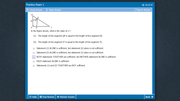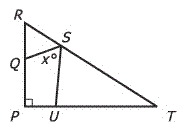
GMAT PREP Practice test quant question
This topic has expert replies
- GMATGuruNY
- GMAT Instructor
- Posts: 15539
- Joined: Tue May 25, 2010 12:04 pm
- Location: New York, NY
- Thanked: 13060 times
- Followed by:1906 members
- GMAT Score:790
Neither statement alone is sufficient to determine the value of x.
When we combine the two statements, here's an efficient way to determine whether we have sufficient information.
1. Plug in values for all of the angle measurements, satisfying the constraints in the problem and the rules of geometry.
2. Calculate the value of x.
3. Plug in different values for all of the angle measurements, again satisfying the constraints in the problem and the rules of geometry.
3. Calculate the value of x.
If the value of x is the SAME in each case, then we have sufficient information to determine the value of x.
If the value of x is NOT the same in each case, then we do NOT have insufficient information to determine the value of x.
Below are two sets of angle measurements that satisfy both the rules of geometry and the constraints in the two statements:
∠PRT + ∠PTR = 90 because triangle PRT is a right triangle.
Since QR=RS, ∠RQS = ∠RSQ.
Since ST=TU, ∠UST = ∠SUT.
Since the sum of angles that form a straight line is 180, x = 180 - ∠RQS - ∠UST.

In each case, x=45.
Thus, when the two statements are combined, we have sufficient information to determine that x=45.
The correct answer is C.
When we combine the two statements, here's an efficient way to determine whether we have sufficient information.
1. Plug in values for all of the angle measurements, satisfying the constraints in the problem and the rules of geometry.
2. Calculate the value of x.
3. Plug in different values for all of the angle measurements, again satisfying the constraints in the problem and the rules of geometry.
3. Calculate the value of x.
If the value of x is the SAME in each case, then we have sufficient information to determine the value of x.
If the value of x is NOT the same in each case, then we do NOT have insufficient information to determine the value of x.
Below are two sets of angle measurements that satisfy both the rules of geometry and the constraints in the two statements:
∠PRT + ∠PTR = 90 because triangle PRT is a right triangle.
Since QR=RS, ∠RQS = ∠RSQ.
Since ST=TU, ∠UST = ∠SUT.
Since the sum of angles that form a straight line is 180, x = 180 - ∠RQS - ∠UST.

In each case, x=45.
Thus, when the two statements are combined, we have sufficient information to determine that x=45.
The correct answer is C.
Private tutor exclusively for the GMAT and GRE, with over 20 years of experience.
Followed here and elsewhere by over 1900 test-takers.
I have worked with students based in the US, Australia, Taiwan, China, Tajikistan, Kuwait, Saudi Arabia -- a long list of countries.
My students have been admitted to HBS, CBS, Tuck, Yale, Stern, Fuqua -- a long list of top programs.
As a tutor, I don't simply teach you how I would approach problems.
I unlock the best way for YOU to solve problems.
For more information, please email me (Mitch Hunt) at [email protected].
Student Review #1
Student Review #2
Student Review #3
Followed here and elsewhere by over 1900 test-takers.
I have worked with students based in the US, Australia, Taiwan, China, Tajikistan, Kuwait, Saudi Arabia -- a long list of countries.
My students have been admitted to HBS, CBS, Tuck, Yale, Stern, Fuqua -- a long list of top programs.
As a tutor, I don't simply teach you how I would approach problems.
I unlock the best way for YOU to solve problems.
For more information, please email me (Mitch Hunt) at [email protected].
Student Review #1
Student Review #2
Student Review #3
- MartyMurray
- Legendary Member
- Posts: 2131
- Joined: Mon Feb 03, 2014 9:26 am
- Location: https://martymurraycoaching.com/
- Thanked: 955 times
- Followed by:140 members
- GMAT Score:800

In the figure shown, what is the value of x?
(1) The length of line segment QR is equal to the length of line segment RS.
(2) The length of line segment ST is equal to the length of line segment TU.
Here's another way to handle this question. From the following you can see why x has the same measure no matter what angles we plug into the triangle.
Statement 1 tells us that triangle QRS is an isosceles triangle. All this means though is that we have cut across the corner of the large triangle in the figure. Angle R could have any measure less than 90 degrees, so the angles of intersection at Q and S could have various measures. Also we have no information that allows us to determine the measures of the angles of intersection of segment SU and the sides of the triangle.
So Statement 1 is insufficient.
Statement 2 on its own is like Statement 1, telling us that triangle STU is isosceles without giving us enough information to determine what any of the angles actually are.
When we combine the statements, something interesting happens.
Since we know that the measure of angle P is 90 degrees, we know that the combined measures of angle R and angle T add up to 90 degrees, because all the measures of the interior angles of a triangle add up to 180 degrees.
Since the measures of R and T add up to 90 degrees, the measures of the other four angles of the two isosceles triangles, QRS and STU, have to add up to (2 x 180) - 90 = 270 degrees. Further, if we take one of each of the base angles of the two isosceles triangles, their measures have to add up to 270/2 = 135 degrees.
So even though we have no way of determining the measures of angle RSQ and angle UST, we can determine that angle RSQ + angle UST = 135 degrees.
Combined, x + angle RSQ + angle UST = 180 degrees.
So x = 180 - 135 = 45 degrees.
Thus, even though there is no way to determine what the measures of most of the angles involved are, combined the statements are sufficient for determining the measure of angle x.
So the correct answer is C.
Marty Murray
Perfect Scoring Tutor With Over a Decade of Experience
MartyMurrayCoaching.com
Contact me at [email protected] for a free consultation.
Perfect Scoring Tutor With Over a Decade of Experience
MartyMurrayCoaching.com
Contact me at [email protected] for a free consultation.



















